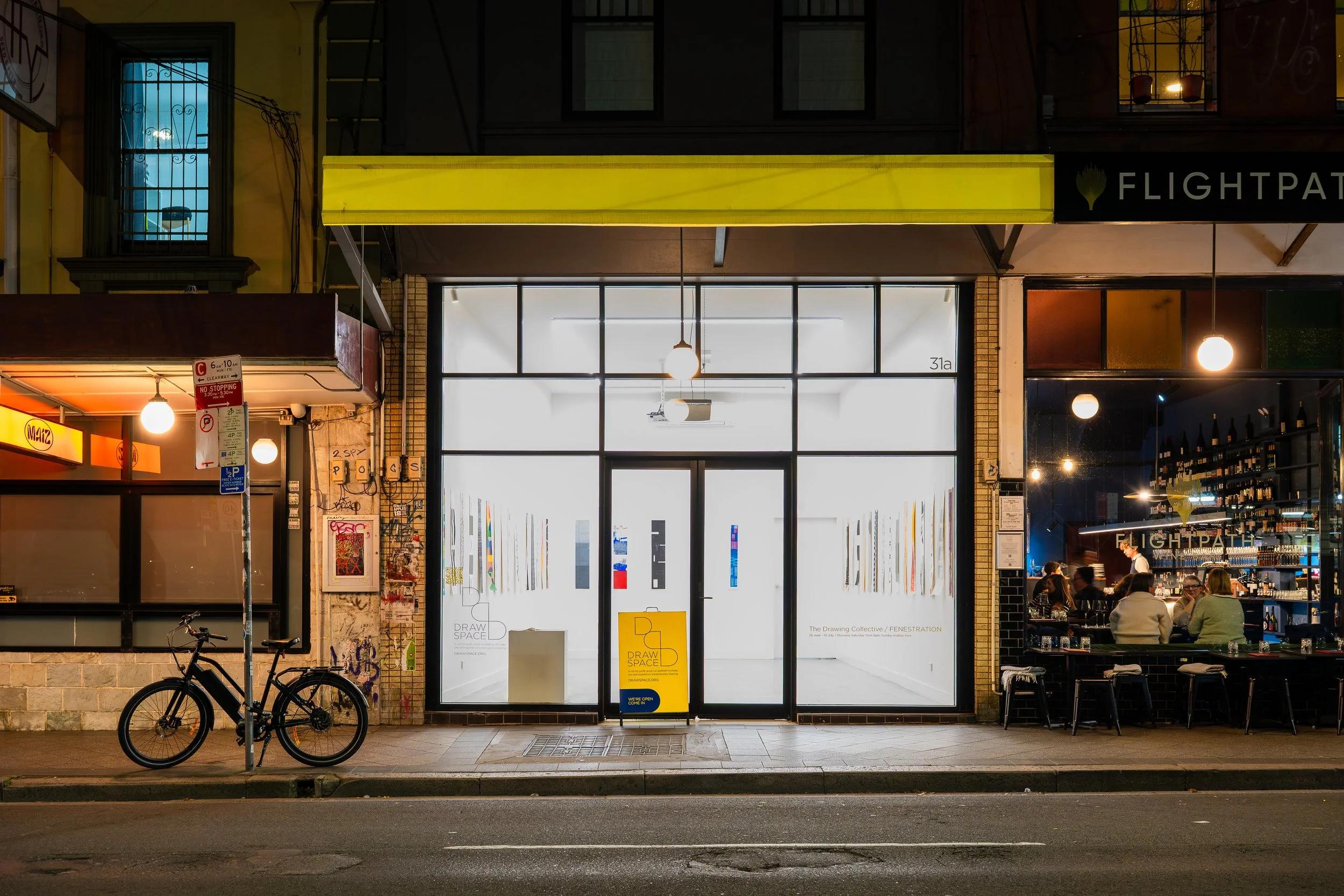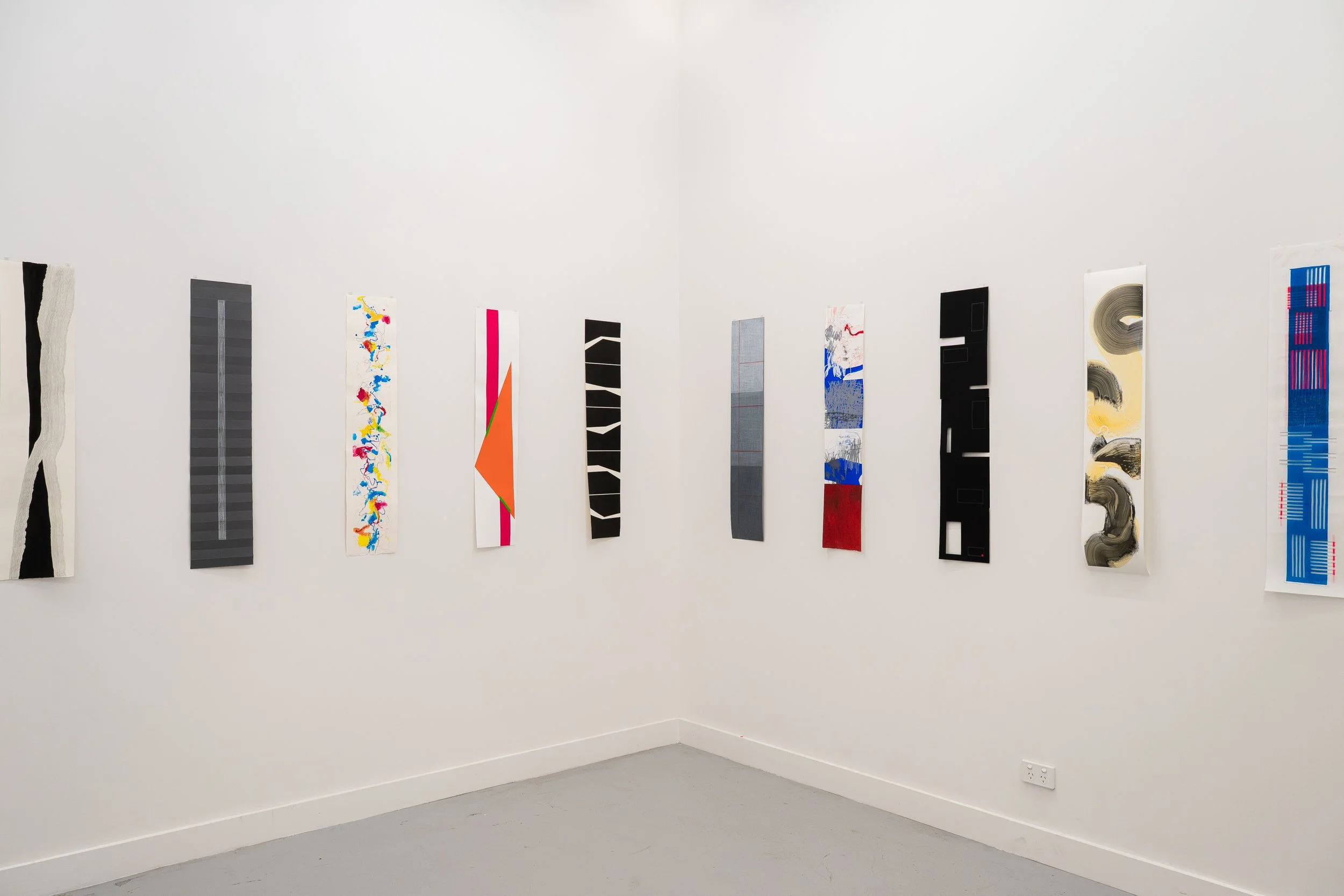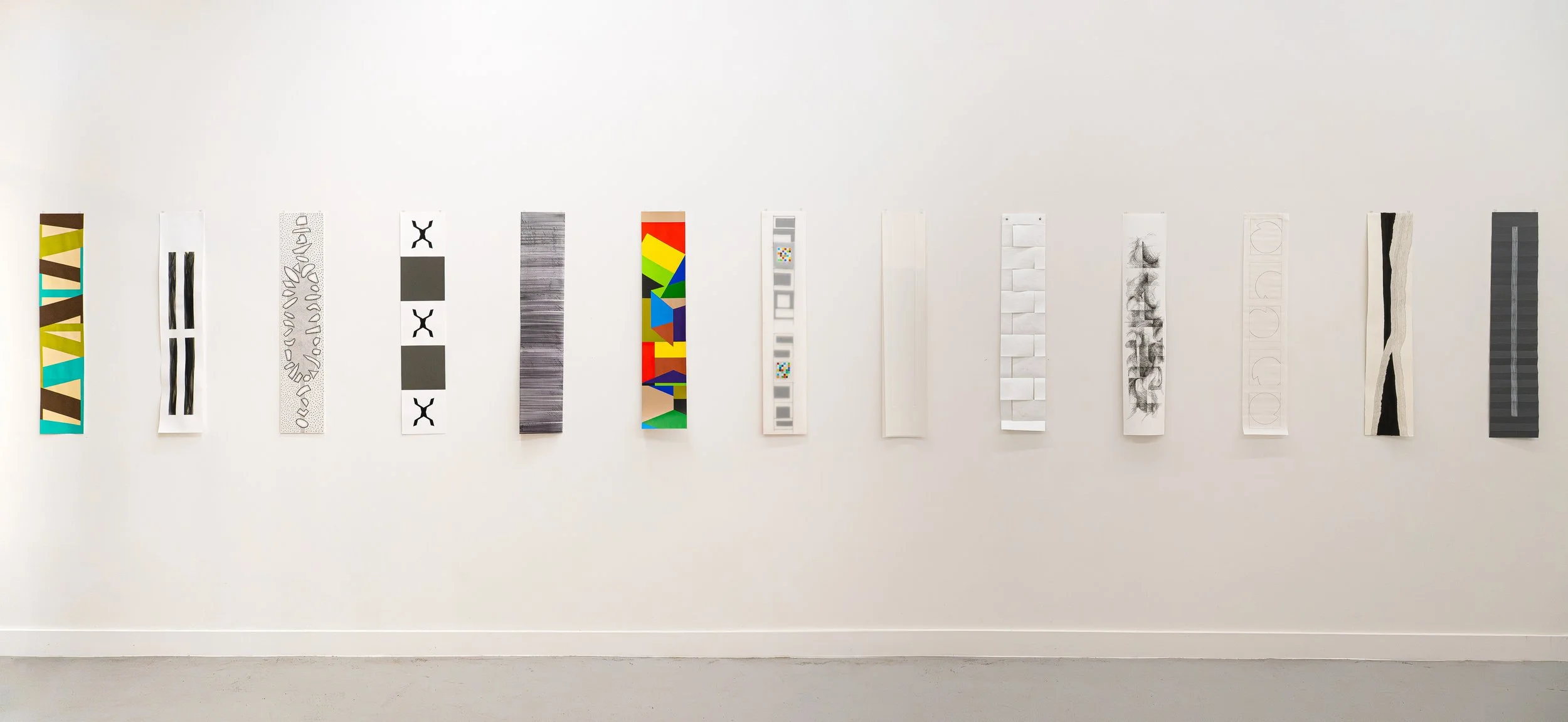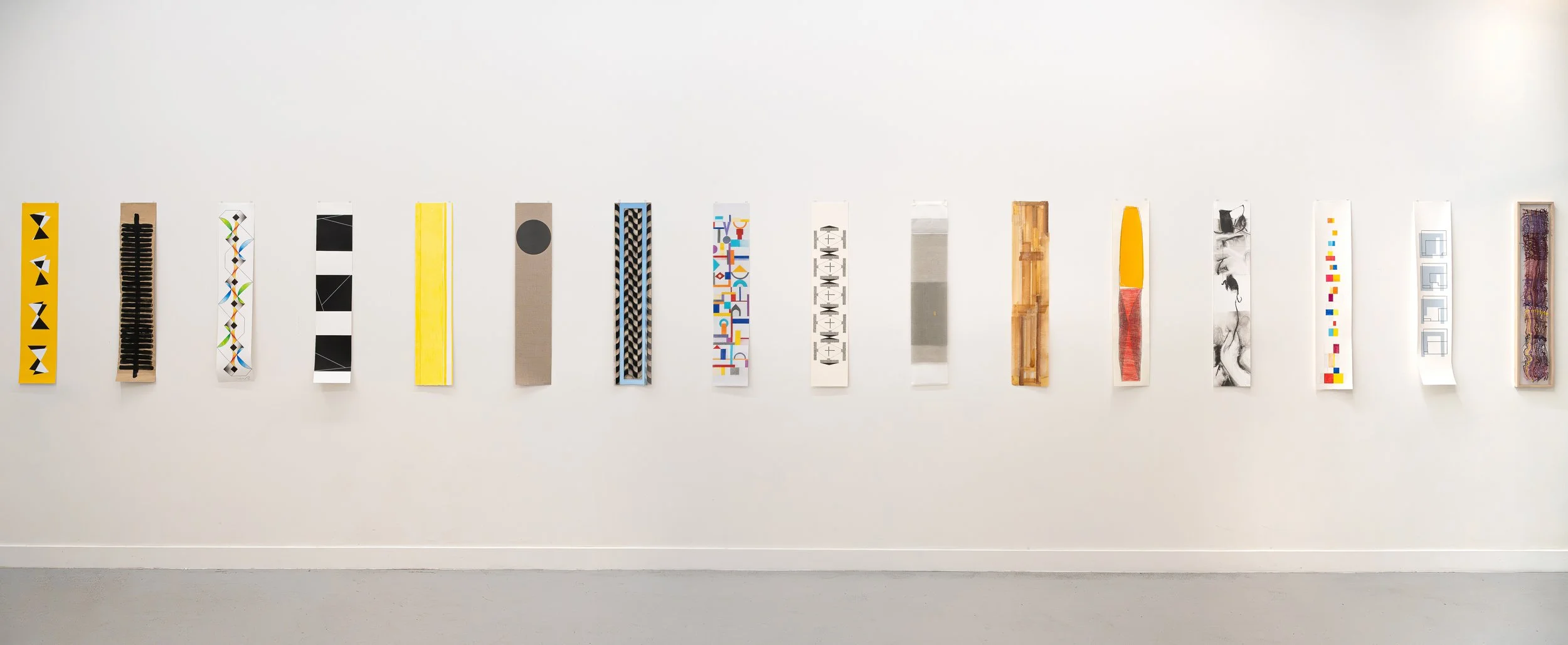Fenestration, an architectural term for the design and placement of multiple windows or other openings in a façade, is at once the title and curatorial construct for this group exhibition. Throughout the history of abstraction, the visualised idea of framed and ordered pictorial space has continued to engage artists, with endless permutations of line, form, colour, material and media made possible.
The device of a portal for looking - a fenestra - between interior and exterior provides site, border, and potent metaphor for multiple drawings made to fit a uniform window. Each artist has been given a window from which they can perch, dangle, reflect, look out, or in, or even close and cover up.
Fenestration presents abstract drawings from The Drawing Collective, a global cohort of 35+ artist-drawers, and in a gesture of amity, alongside drawings by guest artists from DRAW Space.
Munira Naqui and Lisa Pang,
Co-curators, Fenestration
Fenestration installation shots, 2025. Documentation by Richard Trang.
Artists
Wahida Azhari (DE), Milija Belic (FR), Louise Blyton (AU), Lorenzo Bocca (IT), Christine Boiry (FR), Beti Bricelj (SI), Caro Enax (DE), Katharina Fischborn (DE), Daniel G. Hill (US), André Geertse (NL), Ellen F. Golden (US), Gerard van der Horst (NL), Jeff Kellar (US), Erdem Küçükköroglu (TR), Emma Langridge (AU), Danielle Lescot (FR), Marilyn Massey Chapin (FR), Gitte Mørk (DK), Munira Naqui (US), Lisa Pang (AU), Michael Perlbach (DE), Neerja Chandna Peters (IN), Marion Piper (UK), Tineke Porck (NL), Diane Scott (NZ), Jamel Sghaier (DE/TN), Bogumila Strojna (FR), Truong Thanh (VN), Wilma Vissers (NL), Maria de Werker (NL), Mark Wethli (US) with guest artists Sarah Eddowes (AU), James Gardiner (AU), Kristy Gordon (AU), Melinda Hunt (AU), Gary Warner (AU), Belinda Yee (AU)
Beti Bricelj
Untitled, 2025
Acrylic paint and acrylic marker on paper
100 x 20 cm
Wilma Vissers
Untitled, 2025
drawing on paper
100 x 20 cm
Katharina Fischborn
Diaphanous Architecture, 2025 (detail)
Scalpel drawings on unique woodcut prints, Wenzhou paper and offset colour
100 x 20 cm
Christine Boiry
Untitled, 2025 (detail)
Coloured pencil on paper
100 x 20 cm
A short history of the Drawing Collective
Essay by Munira Naqui, Founder, The Drawing Collective
The Drawing Collective started with a whisper of a dream. The idea began with a casual conversation with couple of artist friends one evening in Paris several years ago. The discussion was about abstract drawing and its place in our contemporary practice. This idea germinated over the long intercontinental flight back home that followed. I wondered how the other artists I came to know on the Internet felt about abstract drawing as a common ground to connect across geographic, linguistic and cultural barriers. I had very thoughtful conversations with many on this topic.
I was very lucky to find a group of enthusiastic artists across the globe who pursued a rigorous practice of drawing even when in some cases their focus was elsewhere; and in fields as varied as painting, sculpture, installation and architecture. There was an inherent desire to connect with other fellow artists, to share their work and their ideas. The Drawing Collective was launched in 2014.
The Drawing Collective is a virtual community of 35 artists from 15 countries who are joined in their pursuit and practice of abstract drawing. Tracing the inception of abstraction as a formal device to turn away from representation, and alongside principles of reductive and nonobjective art, artists in this collective actively explore new definitions of drawing and the use of contemporary tools as well as testing the limitations of boundaries.
The conscious selection of the medium of drawing as well as the focus on minimalist principles regarding form is the framework within which these artists create their work. The mission of the Collective is to explore the definition and boundaries of drawing. The artists own their own definition of what drawing means to them. Their work counteracts the apparent separation of art and life, interior and exterior, regionalism and cosmopolitanism, paving the way for art as a universal discourse.
Lorenzo Bocca
Untitled, 2025
Pencils and ink on paper
100 x 20 cm
Sarah Eddowes
Mesh, 2025
Silicone on polyester
100 x 20 cms
Neerja Chandna Peters
Manuscript, 2025
Gouache and watercolour
100 x 20 cm
James Gardiner (fahn)
Paper Sentience PaSe25-10, 2025
Graphite and acrylic polymer on yupo paper
100 x 20 cm
A Composition of Windows[i]
Essay by Lisa Pang
Fenestration, an architectural term for the design and placement of multiple windows or other openings in a façade, is at once the title and curatorial construct for this group exhibition. Throughout the history of non-objective art and of abstraction, the visualised idea of framed and ordered pictorial space has continued to engage artists, with endless permutations of line, form, colour, material and media possible. The device of an aperture for looking - a fenestra[ii] - between interior and exterior provides site, border, and potent metaphor for abstract drawings by The Drawing Collective, a global cohort of artist-drawers. While each drawing was made in isolation to fit a uniform (window-like) format, as a collection of individual units on the gallery walls, they translate into a singular schematic drawing.
Through this fiction of windows, one and many, 37 drawings become sites of camaraderie, complexity, and contemporary contradiction. Each artist has a unique window (100 x 20 cm) a space for drawing, and for looking through / at. Objectively stated, windows are known physical facts in the world, openings for light and air in a building. Located on an oft-drawn plan line between inside and outside and as an array of elements in a façade, fenestration is architectural composition. At its most sublime this might be a single oculus, a pendentive circling of arched windows, stained glass splintering coloured light into a dark interior. At its crudest, it might be an opening in a hut. Not so objectively stated, windows offer poetic (as well as conceptual) apertures. Eyes are said to be the windows to the soul. A window is often a metaphor; in art history, the rectilinear picture frame is often cast as a window into another reality, whether idealised representation or a mode that breaks with the past. Marcel Duchamp installed a window into a gallery as a fresh widow, wearing black leather for panes.[iii] Unlike the opening allowed by a door, a bodily scaled portal, windows are scaled more directly to the gaze. Fenestration in this context is really a way of guiding the act of looking through / at things – here, a collection of abstract drawings. As contemporary artists, we who do look out on our times and events, a window, or a series of windows, is also a good place for making other, non-visual observations.
Camaraderie
The Drawing Collective was founded by artist Munira Naqui over a decade ago. From its inception, when a small group of artists in Paris began discussing what drawing was to them, and what contemporary drawing could be, the group has continued to gather for virtual and actual exhibitions. Its members are united by their work in abstraction as a visual language and drawing as a key aspect of varied studio practices. As Naqui describes it, “abstract drawing (w)as a common ground to connect across geographic, linguistic and cultural barriers.” Now a virtual community of over 35 artists from 15 countries, it is interesting that this type of artist-run collective is very much a feature not only the non-objective / abstract scene[iv] – but also, of the drawing community[v]. What often starts out small and local expands over international networks, fuelled by an ethos of inclusiveness, united by a mutual appreciation for the field and a conviction that there is much to contribute to the contemporary dialogue. Another significant characteristic is that these cohorts move in an alternative current, organising forums and exhibitions independently (though occasionally merging with) the art market, gallery and museum systems. Not driven by profit, production, or sales, these projects are primarily motivated by peer engagement and respect, commitment to content / medium and a lot of goodwill. This Fenestration exhibition continues that trajectory - entirely planned, funded, and managed by its artists from a social media platform and online.
And now to the drawings. They arrived one by one, some days in small groups, bearing the marks of travel - handwritten captions, official customs forms in various languages, even the odd stamp. Not to overextend the analogy, but managing this exhibition was as throwing open a window to the breeze, whims of weather, and the vagaries of international postage. While much was achieved virtually, members still had to make and send their drawings to Sydney as physical artefacts. Due to the rectangular format, mostly the drawings arrived rolled in a tube, but some had been pleated, segmented or folded into a flat parcel. To hold a drawing in your hand that has been made by another artist for a common cause is joyous. Having to chase up a lost drawing with Australia Post is disheartening. Opening a waterlogged parcel to draw out a damaged drawing, heartbreaking. At the letterbox, wonder. I admire the way 37 artists working with the same format, have drawn with such variety, skill, abandon, restraint, and experimentation, on such an intriguing assemblage of substrates and materials. Perhaps no other art form would be so amenable, so light and portable, even so playful as drawing is and therefore how suitable it is for travelling the world in a global art exchange. The directness and immediacy of drawing correlate to an attitude of openness – making for a mindset that makes this type of show possible, despite borders, distances and many of the artists never having met.
Complexity
As has been pointed out, windows are functional objects, yet how susceptible they are to design. If a chair is an acid test for design that supports the reclining human body, then a window is a design that supports how a human body looks - out, in, not, or selectively. There is in existence a Window Research Institute (Japan), promoting among other window-related discourse, windowology. In an exhibition (2020) it noted a chronological parallel between the emergence of linked modernities in abstraction and in fenestration; “the abstract paintings which appeared in the 20th century became in themselves a pattern for windows in the white cube, and their combinations of geometric shapes also look like arrays of windows.”[vi] The advent of glass and steel facades as structural elements enabled simplification of form and minimisation of the decorative; without gables, arches and keystones, windows could become simple geometric shapes arranged on a wall, even occasionally dissolving entirely into all-over glass surfaces.
Fenestration is an architecturally framed exercise to one of the ongoing analyses attached to abstraction – the ‘am I looking through / looking at’ self-consciousness that occurs when we confront an artwork on a flat surface. It is a visual pose often seen as pivotal to understanding the development of modernism, and so, of non-objective, non-representative art and abstraction. As the formal occidental tale tells it, while modernism had inherited a system of visual representation that directed a looking through the picture plane, it had evolved by the mid 20th century to a looking at its flat surface. Arguably, the through to at disarticulation is inherent to looking but it is limited as optical critique. We look as embodied beings, we lean on the window frame, we peer, we hide, and we interpret the view we see through the lens of our lived experience. In art and architecture, the modern has been with us for the best part of a century, as has abstraction, and as we move in the contemporary Contemporary, abstraction as terminology deepens.
Contradiction
Historic and practical considerations of modernity, terminology, the contemporary, and fenestration as the context for these abstract drawings makes for a series of apparent contradictions. All of them are brought to looking. Recently at a lecture on Kazimir Malevich’s iconic Black Square[vii], I was reminded that the literal translation of non-objective was art without objects – specifically meaning a way of stepping away from the world known objects and into the realm of subjective feeling and ideas. But just look at the Black Square now.
That once pure and opaque black surface is now fractured by fine cracks, revealing white ground beneath, two earlier paintings, and even an inappropriate pentimento, such that at and through the Black Square come hidden marks, sensation of time passing, and of other narratives seeping. It is as if, over time, a fine linear over-drawing has appeared, on the square, unintended by the artist yet so evocative for the viewer.
Just as revelations are suggested by the splitting lines of that drawn craquelure, so are they suggested by the titles of these drawings as windows as guides to looking. A few formal Untitleds. Some Fenestrations and a Fenestrae. Slightly more descriptive but factual - Aperture, Composition, Verso Recto, Mesh. Then the referential - In Between, Manuscript, Diverge, Paper Sentience. Ambiguity hovers with Sky Light, Diaphanous Architecture. Increasing the emotional charge, of line, light, shadow and time, Mind Gap, Ruby’s Rainbow, Help is on the Way, and The Moon Looks In. Allusions to people, places and spaces follow - Toponymes, A Poem for Etty Hillesum, Four Short Walks, Tracing Ellsworth in Paris 1949.
Look at and through the 37 abstract drawings that make up the windows of Fenestration, and the world, while not represented, is present. Abstraction is a shifting mode, a sliding scale between drawings of geometric order, seriality and restraint and drawings of scaled gesture, expression and lyricism. This corner of the drawing world – this space, this collective, and this gathering have done much to support and sustain a commitment to (abstract) drawing by acknowledging its past as well as its expanding present.
[i] “When our architecture is necessarily reduced to facades, we architects make a composition of windows. It is like imitating Mondrian with glass.” Gio Ponti, Architect (1891-1979, Milan, IT)
[ii] From Latin, meaning opening, window or pore. Biological meanings include openings in bones and the transparent sections of insect wings.
[iii] Marcel Duchamp, Fresh Widow, 1920, painted wood, leather, 77.5 x 53.3 x 10.2 cm, MoMa New York
[iv] Just from personal experience; Factory 49 Sydney, Factory 49 Paris Pop Up, Abstraction 2018 Melbourne, Abstract Project Paris, Supermarket Art Fair, International Biennale of Non Objective Art, RNOP (Reductive Non Objective Project), Kontruktivist, Discursive Geometry
[v] Draw Space, The Drawing Center New York, Drawing Correspondence UK, Drawing Box
[vi] Igarashi, Taro, Kikuchi, Tatsuya and Shibata, Naomi, “The Window Through a Windowology Perspective” (2019-20) Exhibition Booklet, Window Research Institute, Tokyo, Japan, p19
[vii] Kazimir Malevich, Black Square, 1915, oil on canvas, 79.5 x 79.5 cm, Tretyakov Gallery Moscow
Wahida Azhari
Untitled, 2025
Passepartout paper, acrylic, acrylic pen
100 x 20 cm
Milija Belic
Toponymes, 2025
Ink on paper
100 x 20 cm
Louise Blyton
Sky Light, 2025
Graphite on linen
100 x 20 cm
Caro Enax
André Geertse
A Poem for Etty Hillesum, 2025
Ink on paper
100 x 20 cm
Ellen F. Golden
Untitled, 2025
Ink on paper
100 x 20 cm
Kristy Gordon
Diverge, 2025
Pencil and gouache on paper
100 x 20 cm
Daniel G. Hill
Fenestration 2, 2025
Incised and folded Tyvek, 100 x 20 cm
Melinda Hunt
Four Short Walks, 2025
Acrylic, carbon, graphite and pastel on paper
100 × 20 cm
Gerard van der Horst
Untitled, 2025
Ink on paper
100 x 20 cm
Jeff Kellar
Elevation, 2025
Paper and graphite
100 x 20 cms
Erdem Küçükköroglu
Emma Langridge
Fenestrae, 2025
Ball-point pen on paper
100 x 20 cm
Danielle Lescot
Marilyn Massey Chapin
Ruby's Rainbow, 2025
Gouache, pen and coloured pencil on paper
100 x 20 cm
Gitte Mørk
Untitled, 2025
Charcoal pencil on paper
100 x 20 cm
Munira Naqui
Aperture, 2025
Graphite pencil and cut out on coloured paper
100 x 20 cm
Lisa Pang
Verso Recto, 2025
Aged framing tapes
100 x 20 cm
Michael Perlbach
Help is on the Way, 2025
Ink and glue on Bristol board
100 x 20 cm
Marion Piper
The Moon Looks In, 2025
Pencil and acrylic on canvas
100 x 20 cm
Tineke Porck
Fenestration, 2025
Pencil on polyester
100 x 20 cm
Diane Scott
Jamel Sghaier
Composition, 2025
Acrylic on paper
100 x 20 cm
Bogumila Strojna
Untitled, 2025
Coloured pencils on paper
100 x 20 cm
Truong Thanh
Fenestration, 2025
Acrylic on paper
100 x 20 cm
Gary Warner
Tracing Ellsworth in Paris 1949, 2025
Graphite on paper, draw film
100 x 20 cm
Maria de Werker
Untitled, 2025
Ink, water and charcoal on paper
100 x 20 cm
Mark Wethli
Untitled (Fenestration), 2025
Flashé on canvas paper
100 x 20 cm
Belinda Yee
of line, light, shadow and time, 2025
Watercolour on 425gsm watercolour paper
100 x 20 x .5cm










































